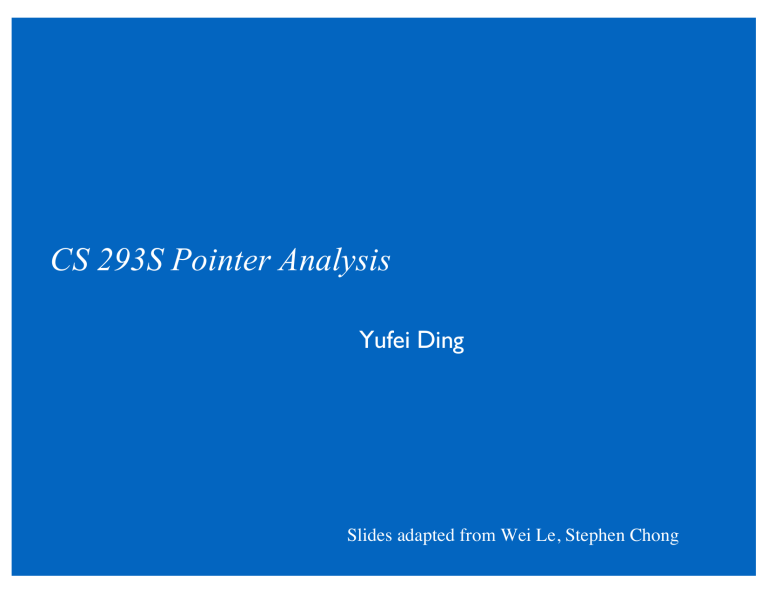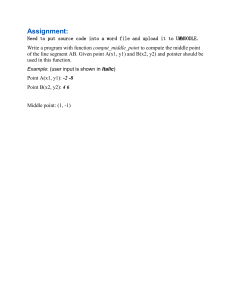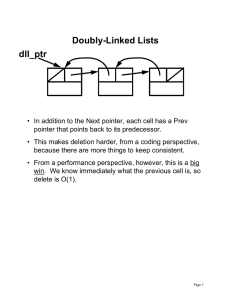
CS 293S Pointer Analysis Yufei Ding Slides adapted from Wei Le, Stephen Chong Focus of this lecture Terms and concepts Algorithms: Andersen-Style and Steensgaard-Style Advanced topics 2 What is Pointer/Alias/points-to Analysis? Pointer analysis statically determines: the possible runtime values of a pointer what storage locations a pointer can point to there are certain models can represent the storage locations: Pointer analysis is hard, but essential for enabling many compiler optimizations. Note: pointer analysis, alias analysis, points-to analysis often are used interchangeably 3 May and Must Aliasing May aliasing: aliasing that may occur during execution (e.g., if (c) p = &i) Must aliasing: aliasing that must occur during execution (e.g., p = &i) Easiest alias analysis: nothing must alias, everything may alias 4 Example Optimizations GCSE needs info on what is read/written: Can p point to a or b? *p = a + b; x = a + b; Reaching definitions and constant propagation: Can p point to x? x = 5; *p = 42; y = x; 5 How Hard Is This Problem? Undecidable [Landi1992] [Ramalingan1994] Approximation algorithms, worst-case complexity, range from almost linear to doubly exponential [Hind2001] Two primary algorithms for point-to analysis Andersen-style Analysis Steensgaard-style Analysis 6 Andersen-Style Pointer Analysis [Andersen1994] Flow-insensitive, context-insensitive analysis First for C programs, later for Java View pointer assignments as subset constraints: 7 Andersen-Style Pointer Analysis Basic idea: map to subset constraints construct the constraint graphs compute transitive closure to propagate points-to relations along the edges of the constraint graphs Constraint graph: one node for each variable representing its points-to set, e.g., pts(p), pts(a) one directed edge for certain constraint 8 Andersen-Style Pointer Analysis: Constructing Constraint Graphs 9 Andersen-Style Pointer Analysis 10 Andersen-style analysis: Algorithm Analysis Can be reduced to computing the transitive closure of a dynamic graph dynamic graph: the graph changes over the analysis of the program the transitive closure of a directed acyclic graph (DAG) is the reachability relation of the DAG. (graph: a set of nodes, and binary relations among the nodes) A well-studied problem for which the best known complexity is O(n3) (n is the number of node) 11 Andersen-Style Pointer Analysis: Cycle Elimination Impart optimization for Anderson-style analysis Detect strongly connected components in points-to graph, collapse to a singe node Why? All nodes in an SCC will have the same points-to relation at the end of analysis How to detect cycles efficiently? Some reduction can be done statically, some on-the-fly as new edges added See Fast and Accurate Pointer Analysis for Millions of Lines of Code, Hardekopf and Lin, PLDI 2007. 12 Andersen-Style Pointer Analysis: Cycle Elimination 13 Steensgaard-Style Pointer Analysis [Steensgaard1996POPL] Points-to Analysis in almost linear time Uses equality constraints instead of subset constraints Unification based approach: assignment unifies the graph nodes, e.g., x = y (unified x and y in the same node), also called union-find algorithm, exclusion-based approaches, nearly linear complexity O(n · α(n)), where α(n) is the inverse Ackermann’s function, α(2132) < 4 Scalable Less precise than Andersen-style, thus more 14 Steensgaard-Style Pointer Analysis Key idea: maintain a set of disjoint sets and supports two operations: FIND(x): return the set containing x UNION(x, y): union the two sets containing x and y 15 Steensgaard-Style Pointer Analysis [Steensgaard1996POPL] 16 Andersen vs. Steensgaard Style Pointer Analysis 17 Andersen vs. Steensgaard Style Pointer Analysis 18 Andersen vs. Steensgaard Style Pointer Analysis 19 Andersen vs. Steensgaard Style Pointer Analysis 20 Points-to Analyses Work in Real Data Flow Problems? 21 Summary: Andersen vs. Steensgaard Both are flow-insensitive and context-insensitive Control flow information is not used, the order of statements is not considered Differ in points-to set construction Andersen-style: many out edges, one variable per node Steensgaard-style: one out edge, many variables per node Andersen-style: inclusion-based, subset-based the slowest but most precise flow-insensitive algorithm Steensgaard-style: equality-based, unification-based the fastest but least precise 22 Advanced point-to analysis The Horwitz-Shapiro Approach: 1997 POPL – Fast and Accurate FlowInsensitive Points-ToAnalysis 23 Advanced point-to analysis 24 Advanced point-to analysis 25 Advanced point-to analysis 26 Advanced point-to analysis 27 Advanced point-to analysis 28 Advanced point-to analysis 29 Advanced point-to analysis 30 Advanced point-to analysis 31 Advanced point-to analysis 32


![[Jeff Blank]](http://s2.studylib.net/store/data/014992494_1-266621985d3d9864a7a0c2841ba167b6-300x300.png)